instrument panel CHEVROLET EXPRESS 2007 Repair Manual
[x] Cancel search | Manufacturer: CHEVROLET, Model Year: 2007, Model line: EXPRESS, Model: CHEVROLET EXPRESS 2007Pages: 440, PDF Size: 2.42 MB
Page 342 of 440
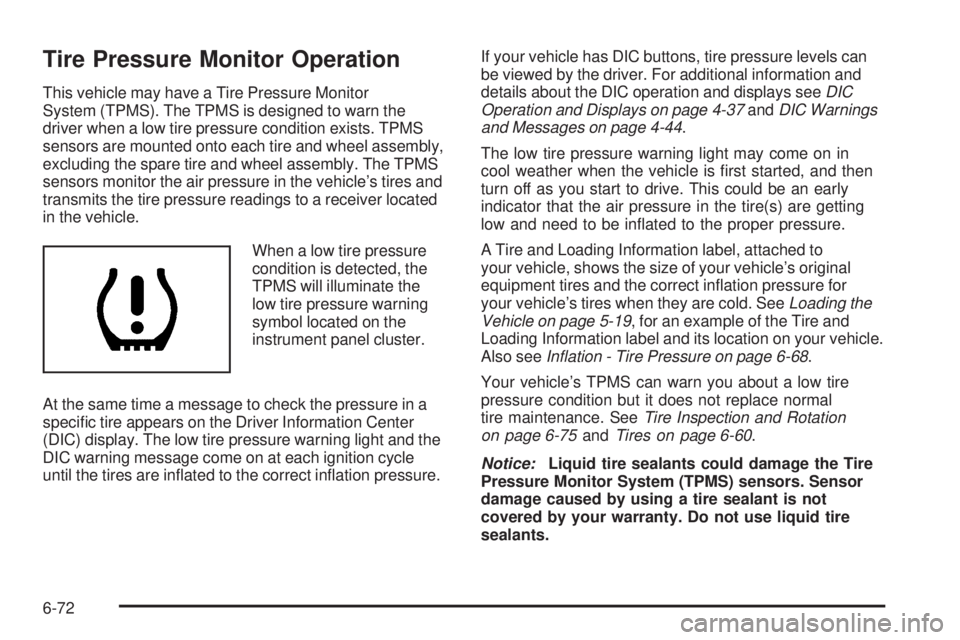
Tire Pressure Monitor Operation
This vehicle may have a Tire Pressure Monitor
System (TPMS). The TPMS is designed to warn the
driver when a low tire pressure condition exists. TPMS
sensors are mounted onto each tire and wheel assembly,
excluding the spare tire and wheel assembly. The TPMS
sensors monitor the air pressure in the vehicle’s tires and
transmits the tire pressure readings to a receiver located
in the vehicle.
When a low tire pressure
condition is detected, the
TPMS will illuminate the
low tire pressure warning
symbol located on the
instrument panel cluster.
At the same time a message to check the pressure in a
specific tire appears on the Driver Information Center
(DIC) display. The low tire pressure warning light and the
DIC warning message come on at each ignition cycle
until the tires are inflated to the correct inflation pressure.If your vehicle has DIC buttons, tire pressure levels can
be viewed by the driver. For additional information and
details about the DIC operation and displays seeDIC
Operation and Displays on page 4-37andDIC Warnings
and Messages on page 4-44.
The low tire pressure warning light may come on in
cool weather when the vehicle is first started, and then
turn off as you start to drive. This could be an early
indicator that the air pressure in the tire(s) are getting
low and need to be inflated to the proper pressure.
A Tire and Loading Information label, attached to
your vehicle, shows the size of your vehicle’s original
equipment tires and the correct inflation pressure for
your vehicle’s tires when they are cold. SeeLoading the
Vehicle on page 5-19, for an example of the Tire and
Loading Information label and its location on your vehicle.
Also seeIn�ation - Tire Pressure on page 6-68.
Your vehicle’s TPMS can warn you about a low tire
pressure condition but it does not replace normal
tire maintenance. SeeTire Inspection and Rotation
on page 6-75andTires on page 6-60.
Notice:Liquid tire sealants could damage the Tire
Pressure Monitor System (TPMS) sensors. Sensor
damage caused by using a tire sealant is not
covered by your warranty. Do not use liquid tire
sealants.
6-72
Page 344 of 440
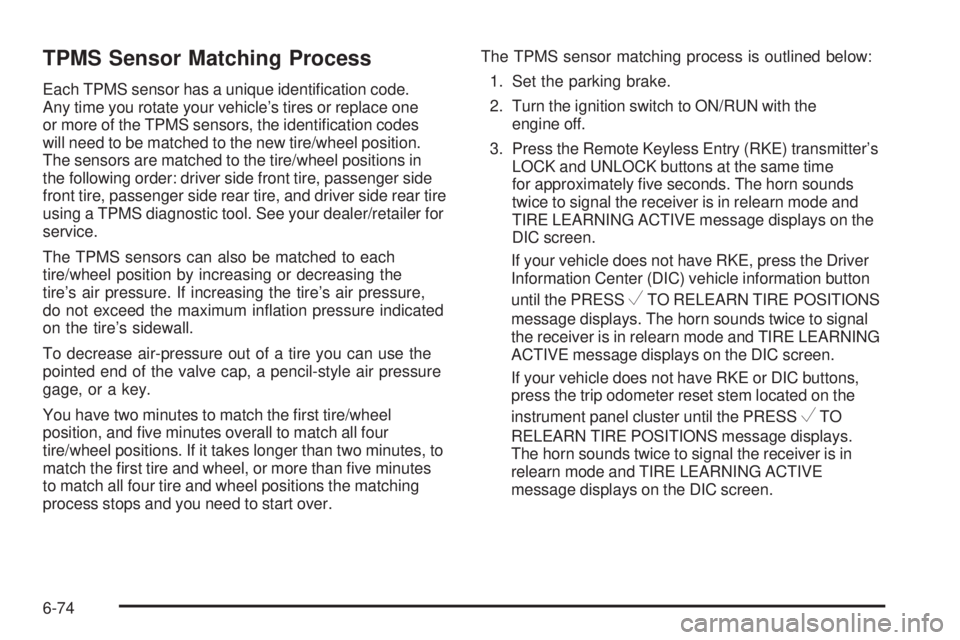
TPMS Sensor Matching Process
Each TPMS sensor has a unique identification code.
Any time you rotate your vehicle’s tires or replace one
or more of the TPMS sensors, the identification codes
will need to be matched to the new tire/wheel position.
The sensors are matched to the tire/wheel positions in
the following order: driver side front tire, passenger side
front tire, passenger side rear tire, and driver side rear tire
using a TPMS diagnostic tool. See your dealer/retailer for
service.
The TPMS sensors can also be matched to each
tire/wheel position by increasing or decreasing the
tire’s air pressure. If increasing the tire’s air pressure,
do not exceed the maximum inflation pressure indicated
on the tire’s sidewall.
To decrease air-pressure out of a tire you can use the
pointed end of the valve cap, a pencil-style air pressure
gage, or a key.
You have two minutes to match the first tire/wheel
position, and five minutes overall to match all four
tire/wheel positions. If it takes longer than two minutes, to
match the first tire and wheel, or more than five minutes
to match all four tire and wheel positions the matching
process stops and you need to start over.The TPMS sensor matching process is outlined below:
1. Set the parking brake.
2. Turn the ignition switch to ON/RUN with the
engine off.
3. Press the Remote Keyless Entry (RKE) transmitter’s
LOCK and UNLOCK buttons at the same time
for approximately five seconds. The horn sounds
twice to signal the receiver is in relearn mode and
TIRE LEARNING ACTIVE message displays on the
DIC screen.
If your vehicle does not have RKE, press the Driver
Information Center (DIC) vehicle information button
until the PRESS
VTO RELEARN TIRE POSITIONS
message displays. The horn sounds twice to signal
the receiver is in relearn mode and TIRE LEARNING
ACTIVE message displays on the DIC screen.
If your vehicle does not have RKE or DIC buttons,
press the trip odometer reset stem located on the
instrument panel cluster until the PRESS
VTO
RELEARN TIRE POSITIONS message displays.
The horn sounds twice to signal the receiver is in
relearn mode and TIRE LEARNING ACTIVE
message displays on the DIC screen.
6-74
Page 374 of 440

If any of the soil remains, a commercial fabric cleaner
or spot lifter may be necessary. When a commercial
upholstery cleaner or spot lifter is to be used, test
a small hidden area for colorfastness first. If the
locally cleaned area gives any impression that a
ring formation may result, clean the entire surface.
After the cleaning process has been completed, a paper
towel can be used to blot excess moisture from the
fabric or carpet.
Instrument Panel, Vinyl, and Other
Plastic Surfaces
A soft cloth dampened with water may be used to remove
dust. If a more thorough cleaning is necessary, a clean
soft cloth dampened with a mild soap solution can be
used to gently remove dust and dirt. Never use spot lifters
or removers on plastic surfaces. Many commercial
cleaners and coatings that are sold to preserve and
protect soft plastic surfaces may permanently change
the appearance and feel of the interior and are not
recommended. Do not use silicone or wax-basedproducts, or those containing organic solvents to
clean the vehicle’s interior because they can alter the
appearance by increasing the gloss in a non-uniform
manner.
Some commercial products may increase gloss on the
instrument panel. The increase in gloss may cause
annoying reflections in the windshield and even make
it difficult to see through the windshield under certain
conditions.
Care of Safety Belts
Keep belts clean and dry.
{WARNING:
Do not bleach or dye safety belts. It may severely
weaken them. In a crash, they might not be able
to provide adequate protection. Clean safety belts
only with mild soap and lukewarm water.
6-104
Page 379 of 440
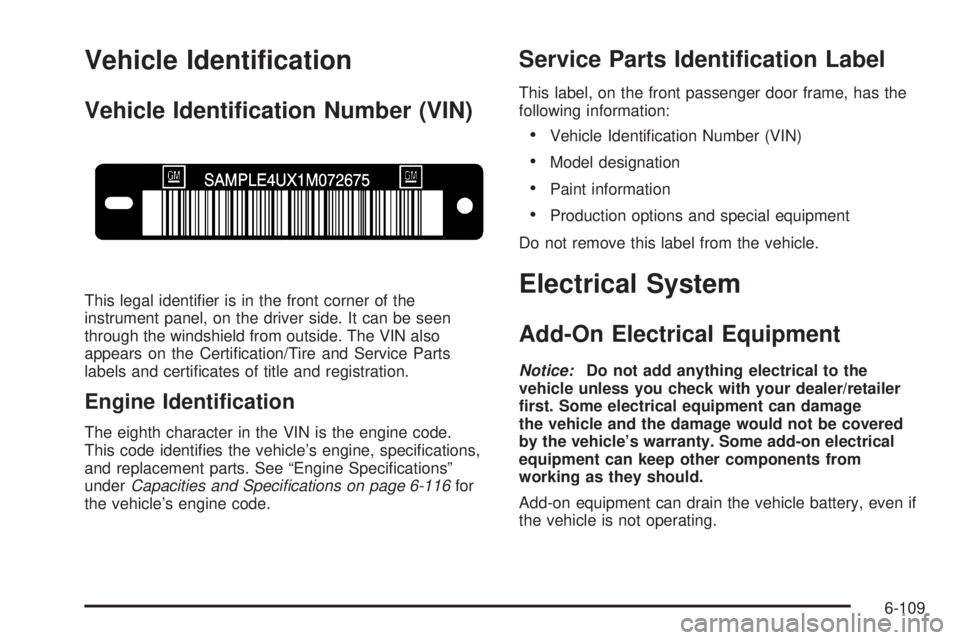
Vehicle Identi�cation
Vehicle Identi�cation Number (VIN)
This legal identifier is in the front corner of the
instrument panel, on the driver side. It can be seen
through the windshield from outside. The VIN also
appears on the Certification/Tire and Service Parts
labels and certificates of title and registration.
Engine Identi�cation
The eighth character in the VIN is the engine code.
This code identifies the vehicle’s engine, specifications,
and replacement parts. See “Engine Specifications”
underCapacities and Speci�cations on page 6-116for
the vehicle’s engine code.
Service Parts Identi�cation Label
This label, on the front passenger door frame, has the
following information:
•Vehicle Identification Number (VIN)
•Model designation
•Paint information
•Production options and special equipment
Do not remove this label from the vehicle.
Electrical System
Add-On Electrical Equipment
Notice:Do not add anything electrical to the
vehicle unless you check with your dealer/retailer
�rst. Some electrical equipment can damage
the vehicle and the damage would not be covered
by the vehicle’s warranty. Some add-on electrical
equipment can keep other components from
working as they should.
Add-on equipment can drain the vehicle battery, even if
the vehicle is not operating.
6-109
Page 382 of 440
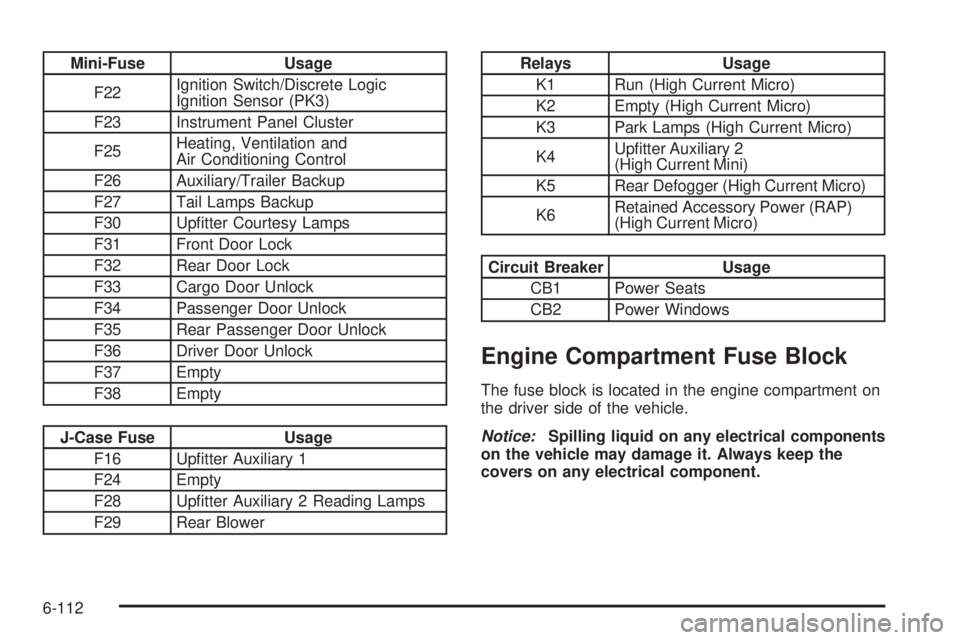
Mini-Fuse Usage
F22Ignition Switch/Discrete Logic
Ignition Sensor (PK3)
F23 Instrument Panel Cluster
F25Heating, Ventilation and
Air Conditioning Control
F26 Auxiliary/Trailer Backup
F27 Tail Lamps Backup
F30 Upfitter Courtesy Lamps
F31 Front Door Lock
F32 Rear Door Lock
F33 Cargo Door Unlock
F34 Passenger Door Unlock
F35 Rear Passenger Door Unlock
F36 Driver Door Unlock
F37 Empty
F38 Empty
J-Case Fuse Usage
F16 Upfitter Auxiliary 1
F24 Empty
F28 Upfitter Auxiliary 2 Reading Lamps
F29 Rear Blower
Relays Usage
K1 Run (High Current Micro)
K2 Empty (High Current Micro)
K3 Park Lamps (High Current Micro)
K4Upfitter Auxiliary 2
(High Current Mini)
K5 Rear Defogger (High Current Micro)
K6Retained Accessory Power (RAP)
(High Current Micro)
Circuit Breaker Usage
CB1 Power Seats
CB2 Power Windows
Engine Compartment Fuse Block
The fuse block is located in the engine compartment on
the driver side of the vehicle.
Notice:Spilling liquid on any electrical components
on the vehicle may damage it. Always keep the
covers on any electrical component.
6-112
Page 383 of 440
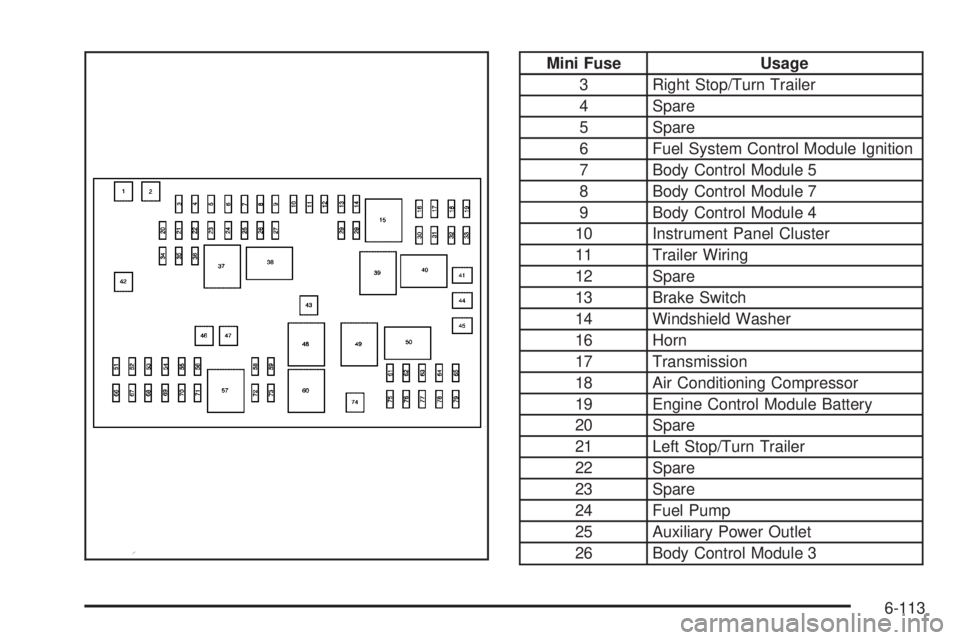
Mini Fuse Usage
3 Right Stop/Turn Trailer
4 Spare
5 Spare
6 Fuel System Control Module Ignition
7 Body Control Module 5
8 Body Control Module 7
9 Body Control Module 4
10 Instrument Panel Cluster
11 Trailer Wiring
12 Spare
13 Brake Switch
14 Windshield Washer
16 Horn
17 Transmission
18 Air Conditioning Compressor
19 Engine Control Module Battery
20 Spare
21 Left Stop/Turn Trailer
22 Spare
23 Spare
24 Fuel Pump
25 Auxiliary Power Outlet
26 Body Control Module 3
6-113
Page 408 of 440
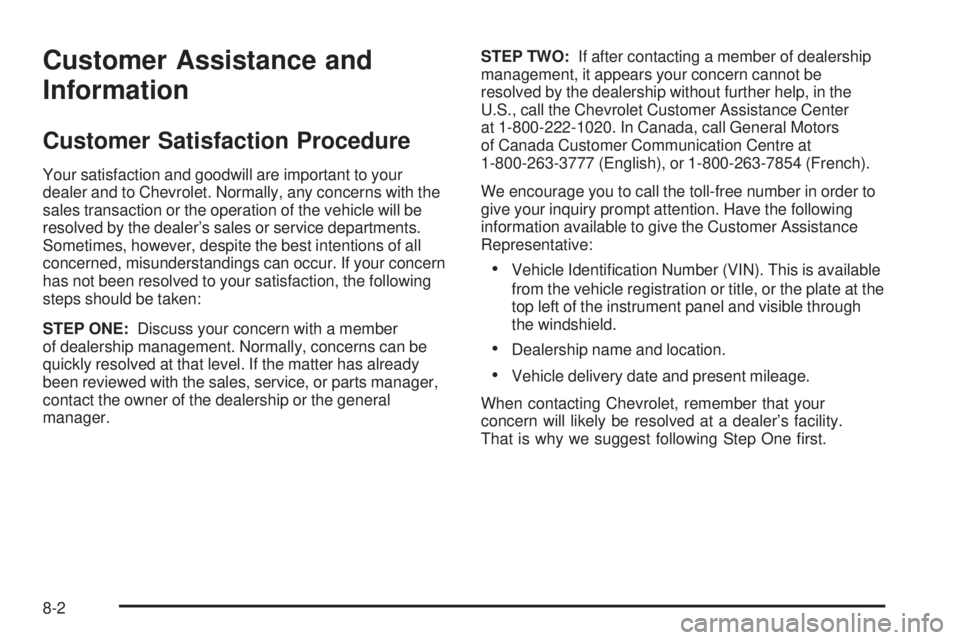
Customer Assistance and
Information
Customer Satisfaction Procedure
Your satisfaction and goodwill are important to your
dealer and to Chevrolet. Normally, any concerns with the
sales transaction or the operation of the vehicle will be
resolved by the dealer’s sales or service departments.
Sometimes, however, despite the best intentions of all
concerned, misunderstandings can occur. If your concern
has not been resolved to your satisfaction, the following
steps should be taken:
STEP ONE:Discuss your concern with a member
of dealership management. Normally, concerns can be
quickly resolved at that level. If the matter has already
been reviewed with the sales, service, or parts manager,
contact the owner of the dealership or the general
manager.STEP TWO:If after contacting a member of dealership
management, it appears your concern cannot be
resolved by the dealership without further help, in the
U.S., call the Chevrolet Customer Assistance Center
at 1-800-222-1020. In Canada, call General Motors
of Canada Customer Communication Centre at
1-800-263-3777 (English), or 1-800-263-7854 (French).
We encourage you to call the toll-free number in order to
give your inquiry prompt attention. Have the following
information available to give the Customer Assistance
Representative:
•Vehicle Identification Number (VIN). This is available
from the vehicle registration or title, or the plate at the
top left of the instrument panel and visible through
the windshield.
•Dealership name and location.
•Vehicle delivery date and present mileage.
When contacting Chevrolet, remember that your
concern will likely be resolved at a dealer’s facility.
That is why we suggest following Step One first.
8-2
Page 427 of 440
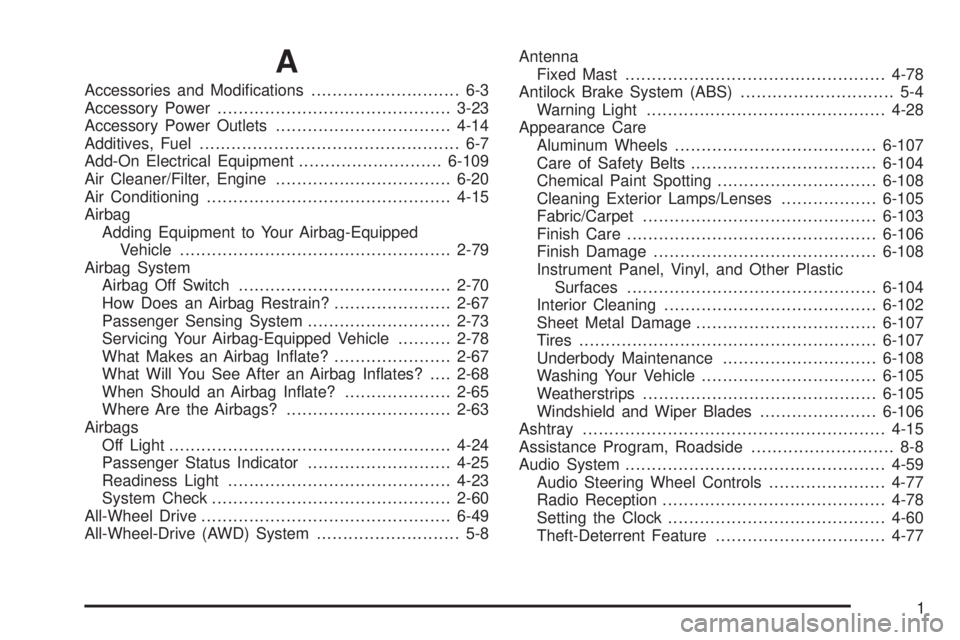
A
Accessories and Modifications............................ 6-3
Accessory Power............................................3-23
Accessory Power Outlets.................................4-14
Additives, Fuel................................................. 6-7
Add-On Electrical Equipment...........................6-109
Air Cleaner/Filter, Engine.................................6-20
Air Conditioning..............................................4-15
Airbag
Adding Equipment to Your Airbag-Equipped
Vehicle...................................................2-79
Airbag System
Airbag Off Switch........................................2-70
How Does an Airbag Restrain?......................2-67
Passenger Sensing System...........................2-73
Servicing Your Airbag-Equipped Vehicle..........2-78
What Makes an Airbag Inflate?......................2-67
What Will You See After an Airbag Inflates?....2-68
When Should an Airbag Inflate?....................2-65
Where Are the Airbags?...............................2-63
Airbags
Off Light.....................................................4-24
Passenger Status Indicator...........................4-25
Readiness Light..........................................4-23
System Check.............................................2-60
All-Wheel Drive...............................................6-49
All-Wheel-Drive (AWD) System........................... 5-8Antenna
Fixed Mast.................................................4-78
Antilock Brake System (ABS)............................. 5-4
Warning Light.............................................4-28
Appearance Care
Aluminum Wheels......................................6-107
Care of Safety Belts...................................6-104
Chemical Paint Spotting..............................6-108
Cleaning Exterior Lamps/Lenses..................6-105
Fabric/Carpet............................................6-103
Finish Care...............................................6-106
Finish Damage..........................................6-108
Instrument Panel, Vinyl, and Other Plastic
Surfaces...............................................
6-104
Interior Cleaning........................................6-102
Sheet Metal Damage..................................6-107
Tires........................................................6-107
Underbody Maintenance.............................6-108
Washing Your Vehicle.................................6-105
Weatherstrips............................................6-105
Windshield and Wiper Blades......................6-106
Ashtray.........................................................4-15
Assistance Program, Roadside........................... 8-8
Audio System.................................................4-59
Audio Steering Wheel Controls......................4-77
Radio Reception..........................................4-78
Setting the Clock.........................................4-60
Theft-Deterrent Feature................................4-77
1
Page 429 of 440
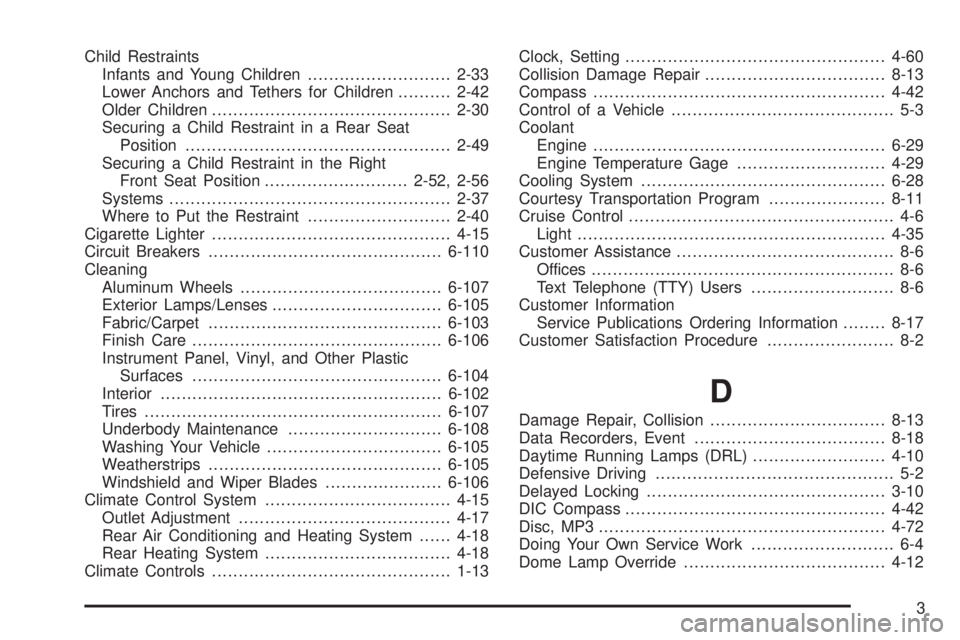
Child Restraints
Infants and Young Children...........................2-33
Lower Anchors and Tethers for Children..........2-42
Older Children.............................................2-30
Securing a Child Restraint in a Rear Seat
Position..................................................2-49
Securing a Child Restraint in the Right
Front Seat Position...........................2-52, 2-56
Systems.....................................................2-37
Where to Put the Restraint...........................2-40
Cigarette Lighter.............................................4-15
Circuit Breakers............................................6-110
Cleaning
Aluminum Wheels......................................6-107
Exterior Lamps/Lenses................................6-105
Fabric/Carpet............................................6-103
Finish Care...............................................6-106
Instrument Panel, Vinyl, and Other Plastic
Surfaces...............................................6-104
Interior.....................................................6-102
Tires........................................................6-107
Underbody Maintenance.............................6-108
Washing Your Vehicle.................................6-105
Weatherstrips............................................6-105
Windshield and Wiper Blades......................6-106
Climate Control System...................................4-15
Outlet Adjustment........................................4-17
Rear Air Conditioning and Heating System......4-18
Rear Heating System...................................4-18
Climate Controls.............................................1-13Clock, Setting.................................................4-60
Collision Damage Repair..................................8-13
Compass.......................................................4-42
Control of a Vehicle.......................................... 5-3
Coolant
Engine.......................................................6-29
Engine Temperature Gage............................4-29
Cooling System..............................................6-28
Courtesy Transportation Program......................8-11
Cruise Control.................................................. 4-6
Light..........................................................4-35
Customer Assistance......................................... 8-6
Offices......................................................... 8-6
Text Telephone (TTY) Users........................... 8-6
Customer Information
Service Publications Ordering Information........8-17
Customer Satisfaction Procedure........................ 8-2
D
Damage Repair, Collision.................................8-13
Data Recorders, Event....................................8-18
Daytime Running Lamps (DRL).........................4-10
Defensive Driving............................................. 5-2
Delayed Locking.............................................3-10
DIC Compass.................................................4-42
Disc, MP3......................................................4-72
Doing Your Own Service Work........................... 6-4
Dome Lamp Override......................................4-12
3
Page 432 of 440
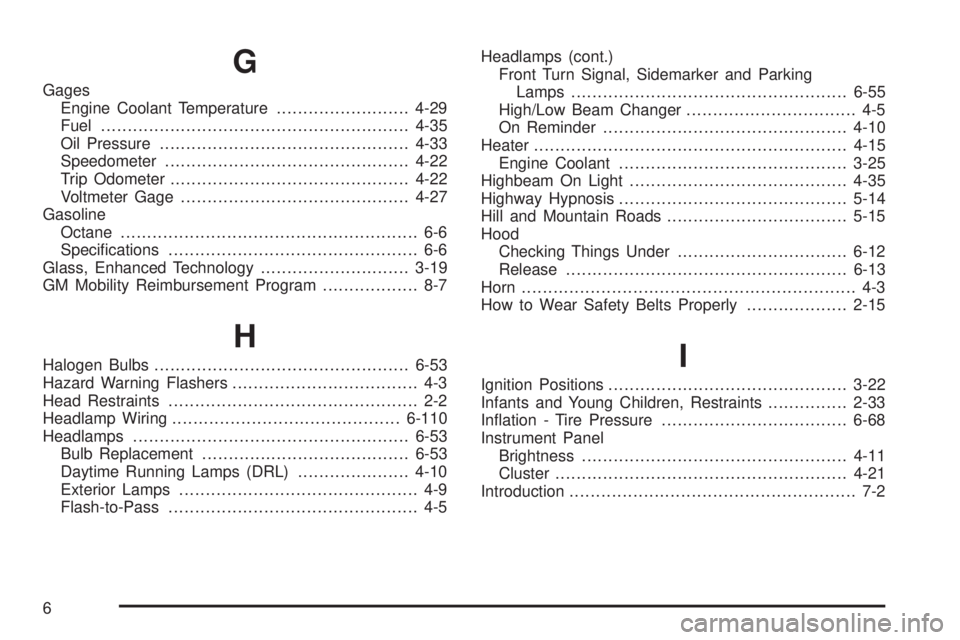
G
Gages
Engine Coolant Temperature.........................4-29
Fuel..........................................................4-35
Oil Pressure...............................................4-33
Speedometer..............................................4-22
Trip Odometer.............................................4-22
Voltmeter Gage...........................................4-27
Gasoline
Octane........................................................ 6-6
Specifications............................................... 6-6
Glass, Enhanced Technology............................3-19
GM Mobility Reimbursement Program.................. 8-7
H
Halogen Bulbs................................................6-53
Hazard Warning Flashers................................... 4-3
Head Restraints............................................... 2-2
Headlamp Wiring...........................................6-110
Headlamps....................................................6-53
Bulb Replacement.......................................6-53
Daytime Running Lamps (DRL).....................4-10
Exterior Lamps............................................. 4-9
Flash-to-Pass............................................... 4-5Headlamps (cont.)
Front Turn Signal, Sidemarker and Parking
Lamps ....................................................6-55
High/Low Beam Changer................................ 4-5
On Reminder..............................................4-10
Heater...........................................................4-15
Engine Coolant...........................................3-25
Highbeam On Light.........................................4-35
Highway Hypnosis...........................................5-14
Hill and Mountain Roads..................................5-15
Hood
Checking Things Under................................6-12
Release.....................................................6-13
Horn ............................................................... 4-3
How to Wear Safety Belts Properly...................2-15I
Ignition Positions.............................................3-22
Infants and Young Children, Restraints...............2-33
Inflation - Tire Pressure...................................6-68
Instrument Panel
Brightness..................................................4-11
Cluster.......................................................4-21
Introduction...................................................... 7-2
6